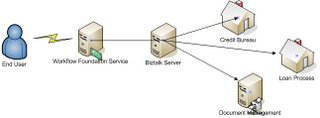Yesterday I attended
.NET Code Camp in Reston, VA. Before I went there, I had wondered how well it would be, because many good speakers went to TechEd 2006 in Boston. If this code camp had been scheduled days ahead of TechEd, maybe some TechEd speakers would attend the code camp to practice their topics. "Anyway, I will go there to have a look on this beautiful Saturday", so I went there in the morning.
According to the session schedule, some good speakers were not there of course, but I did find several good speakers on the list! :)
The schedule included five tracks: Web track, Data track, Smart Client track, Miscellaneous track, and Security track. There were no much stuff on WinFX (.NET 3.0). Below are the sessions I attended:
1) "Enterprise Library and Data Security": Gary Blatt was still humorous. It's pleasure to listen to his speech. He did not talk about Enterprise Library 2.0 though.
2) "Secure Click Once Smart Client Deployment": MS Regional Director - Brian Noyes' speech was full of exciting technology to me! :) He showed his broad knowledge on .NET platform. Actually, it was the first time for me to see a real "Click Once" (or Click Twice) deployment.
In his speech, Brian showed deployment and application manifest files for an assembly. Whenever an assembly is deployed, new manifest files will include hash code for its XML content, and application manifest file also includes hash code for DLL files. In this way, it is quite difficult for hackers to replace DLL files or to change manifest content.
On user side, Smart Client application runs code according to deployment server URL, so that user can run applications side-by-side deployed from QA server and production server.
It is impossible for me to write down all what I learned from this session. I will wait for his coming MSDN Online article about Secure Click Once Deployment.
3) "Refactoring: Why? When? How?": C# MVP Jonathan Cogley is also one of my favorite speakers (I attended two of his sessions :>). He did not prepare PowerPoint slides. What he did was to show in Visual Studio how to make existing code better for maintenace and performance purposes using refactoring techniques (Rename, Extract Method, Move Method, Introducing Explaining Variable, etc.) and tools (e.g. ReSharper, NUnit). To see a smart guy changing code step by step is really a good learning experience! :)
4) "Web Applications Security: Greatest Hits": Jonathan Cogley demonstrated SQL Injection and Cross-Site Script Attack in ASP.NET application, and how to change code to avoid attacks. Some concepts were not new to me, but I still got some good hints.
For example, we may separate input pages with HTML editor from other input pages. HTML editor accepts Java Script in the textbox, so we should disable Request Validation for that page. For other input pages, we should enable ASP.net Request Validation to avoid script attack.
5) "SQL Server Integration Services with Team Systems": Andy Leonard had planned to show Team system, but unfortunately his VPC died at that time. Instead, he showed us more exciting SSIS feathers. What surprised me in SSIS was its step-by-step debug capability inside Visual Studio.
Andy mentioned that DBA should be involved in Software Development Life Cycle to make system better. I totally agree with him. Nowadays, many systems are designed without DBA, Tester, even Developers being involved --- How can they develop the system without misunderstanding?
6) "Building Ajax Style Applications using ASP.NET 2.0 and Atlas": MS Regional Director Vishwas Lele showed some cool features of Atlas. He made it clear that Atlas does not use ASP.NET 2.0 Callback feature, it uses a special HTTP Handler to process JSON request directly without going through the whole ASP.NET page cycle.
Overall, although I did not see topics about latest .NET 3.0, I still learned a lot from this code camp and went back home happily! :)












